Chichester Harbour is a very special and unique location. Situated on the south coast of the UK stretching across West Sussex and Hampshire the area is a National Landscape, with a range of national and internal designations.
Whilst it may feel quite large, Chichester Harbour is only 74km2 and includes land, sea and intertidal areas. There are very few, if any, other harbours of this size. Chichester Harbour is home to many different types of habitat:
- Saltwater and freshwater – offering specialised micro-habitats which support many types of aquatic plants and animals.
- Mudflats – providing feeding and resting areas for internationally important migrant and wintering waterfowl, and nursery areas for fish.
- Saltmarsh – one of the largest areas of saltmarsh in the UK; many plants growing on saltmarsh are not found anywhere else, making it an internationally important habitat.
- Shoreline – including shingle beaches leading up to the strandline supporting creatures, especially invertebrates.
- Sand dunes – providing a home to skylarks, meadow pipets, ringed plovers and oystercatchers.
- Reedbeds – situated at Chichester Marina, Fishbourne Meadows, Emsworth and Thorney Island these areas are very important for bird life and mammals, including the water vole.
- Grassland – the pastures of Fishbourne Meadows and areas of West Chidham include flower-filled field margins, hedgerows, reed-lined ponds and seed-filled stubbles.
- Woodland – the most diverse of all the habitats found in Chichester Harbour with the two largest woodlands, at Old Park Wood and Tournerbury, both private estates. Other small copses found around the Harbour are vital to the natural landscape.
The Harbour also supports several hundred businesses and farms, and over 4,000 houses and 10,000 residents. Each year more than 1.3 million people visit, to explore over 500 historic sites and almost 100km of public rights of way. On the water Chichester Harbour has more than 3,200 moorings, 2,000 berths in six marinas, 16 sailing clubs, and over 9,000 vessels.

Discover Chichester Harbour – visit our Explore section to find out how to make the most of your visit with our walking and cycling routes, family activities and information about how to get here and parking.